tp
Developer Guide
- Acknowledgements
- Design
- Implementation
- Product scope
- User stories
- Non-functional requirements
- Glossary
- Manual testing
Acknowledgements
Data source
- Adapted from NUS EduRec, data was collected manually as a collective effort from the team.
Third Party Library Used
‘org.glassfish:javax.json:1.1.4’
‘javax.json:javax.json-api:1.1.4’
Design
Architecture

The Architecture Diagram given above explains the high-level design of the App.
Given below is a quick overview of main components and how they interact with each other.
Main components of the architecture
ExchangeCourseMapper class (referred to as Main in diagram) is responsible for the app launch and shut down.
- At app launch, it initializes the other components in the correct sequence, and connects them up with each other.
- At shut down, it shuts down the other components and invokes cleanup methods where necessary.
The bulk of the app’s work is done by the following four components:
UI: The UI of the App.
Parser: The command executor and logic checker.
Command: Details and implementation of various commands/features of the app.
Storage: Reads data from, and writes data to, mylist.json.
How the architecture components interact with each other
Only some of the commands will need all 4 main components for example the Delete course command:
The Sequence Diagram below shows how the components interact with each other for the scenario
where the user issues the command delete 1.
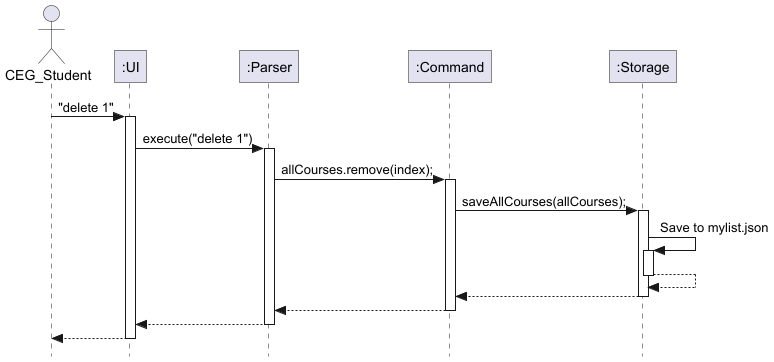
The UI, Parser and Storage components (also shown in the diagram above),
- defines its API in a class with the same name as the Package
The Command component,
- defines its API in an
abstractclass with the same name as the Component. - further splits them into
CheckInformationCommandandPersonalTrackerCommandas child classes - further split them into the various commands
For example, the Command component defines its API in the Command.java abstract class and extends its functionality using the
PersonalTrackerCommand.java and CheckInformationCommand class. Other components such as ListSchoolsCommand and DeleteCoursesCommand
interact with a given component through its interface rather than the concrete class
(reason: to prevent outside component’s being coupled to the implementation of a component), as illustrated in the (partial) class diagram below.
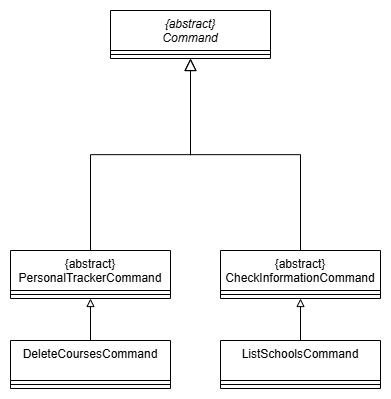
The sections below give more details of the components and any additional components.
Class Diagrams
Command Structure:

The abstract command classes for our two main features, CheckInformationCommand and PersonalTrackerCommand.
must inherit from the abstract Command class, which has the method to read the Json file containing course
information. Each child class has the abstract execute method, to be implemented by their concrete child classes,
specific to the command functionality.
Addition of new command features
When adding new command classes, developers should make sure that the concrete class inherits from either the
CheckInformationCommand or PersonalTrackerCommand classes, depending on the new command’s functionality.
The new command class should also have an implementation of the execute method, and uses the UI class to
print messages on the CLI interface.
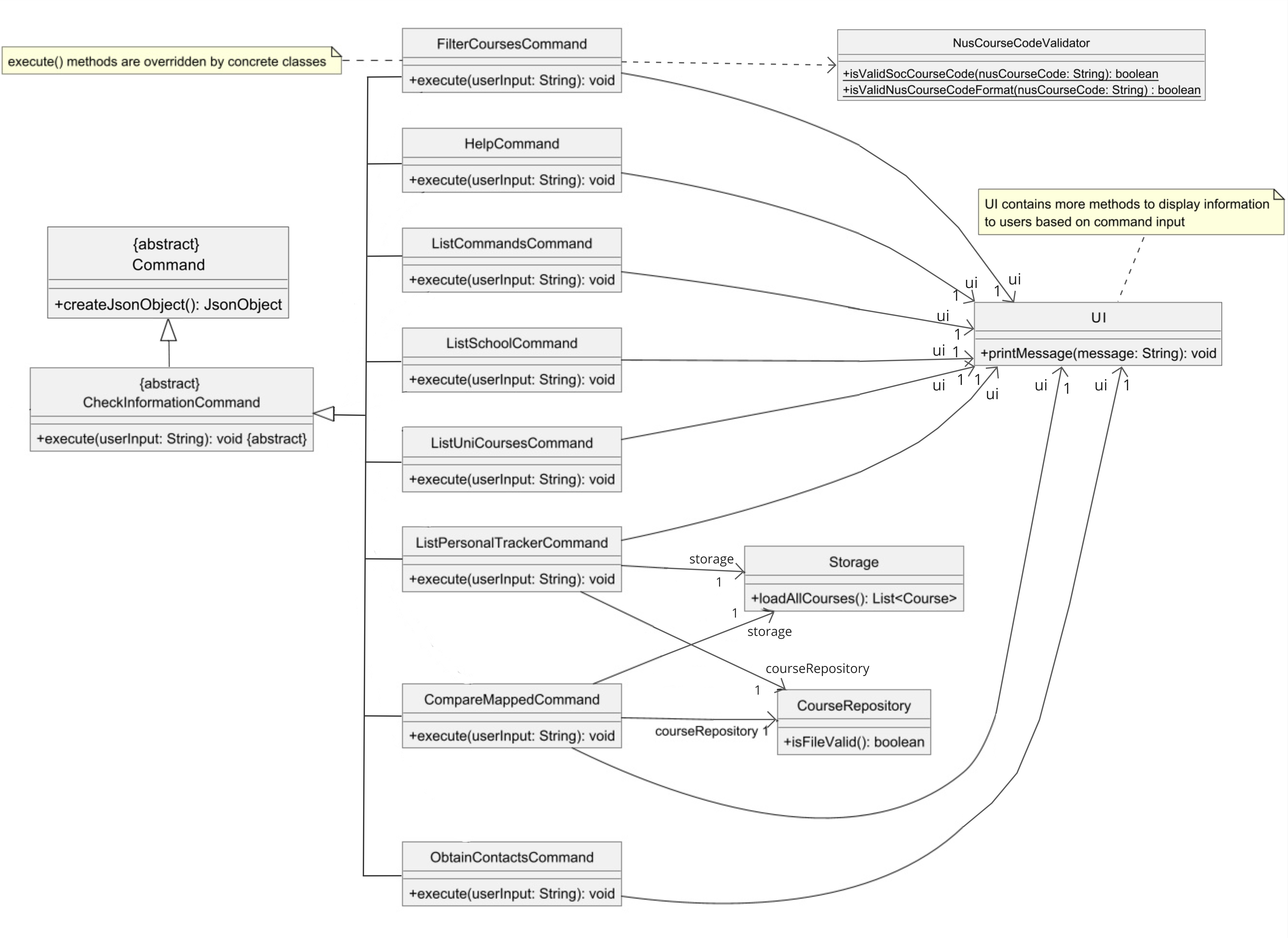
CheckInformationCommands list out information from the JSON file containing course mapping information, or from the
user’s Personal Tracker.
Possible CheckInformationCommands are:
ListCommandsCommandHelpCommandListSchoolsCommandListUniCoursesCommandObtainContactsCommandFilterCoursesCommandListPersonalTrackerCommandCompareMappedCommand
The above list of Command classes are concrete classes, and must implement the abstract
execute(userInput) method.
![]()
PersonalTrackerCommands are commands that can modify the user’s saved mapping plans from the Personal Tracker,
as well as access the list of saved mappings.
Possible CheckInformationCommands are:
AddCoursesCommandDeleteCoursesCommandFindCoursesCommand
The above list of Command classes are concrete classes, and must implement the abstract
execute(userInput, storage) method.
Parser class diagram:
The Parser class is responsible for handling and interpreting user input in the application. It reads user commands, processes them by splitting the input into command keywords and parameters, and then directs the flow of control to the appropriate command classes to execute the specified actions.
As ExchangeCourseMapper is mainly split into two main parts; Check Information and Personal Tracker. We decided to
split the Parser class diagram into the two parts respectively to increase readability and neatness.
This class diagram represents the parsing of commands in Check Information. The multiplicities dependencies of the command are 0 or 1 because the dependency is only formed when the command is called, else, it will be zero.
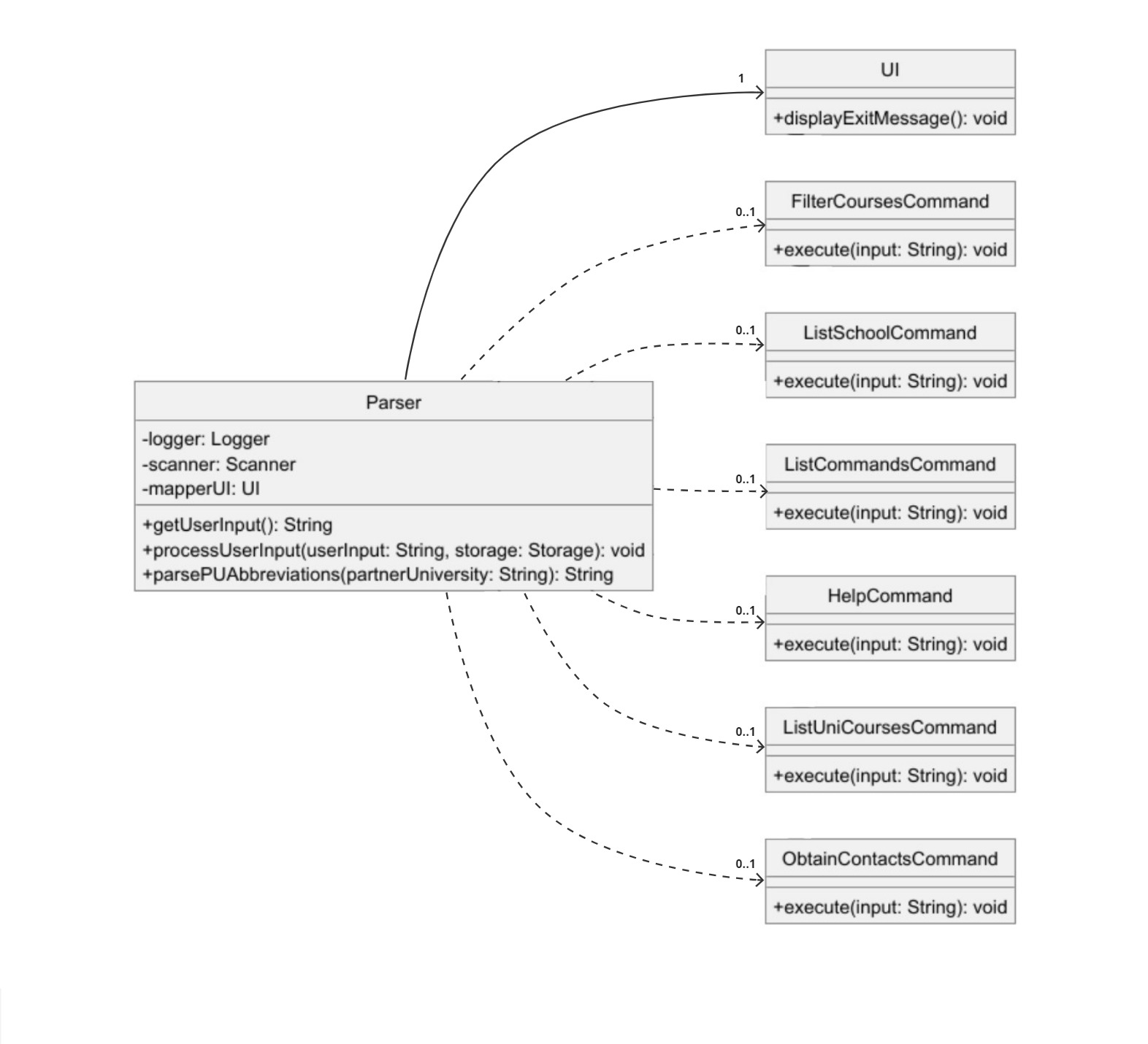
This class diagram represents the parsing of commands in Personal Tracker. The Parser class has associations with the
UI class and Storage class and dependencies with the commands in Personal Tracker.
![]()
CourseValidator Class Diagram:
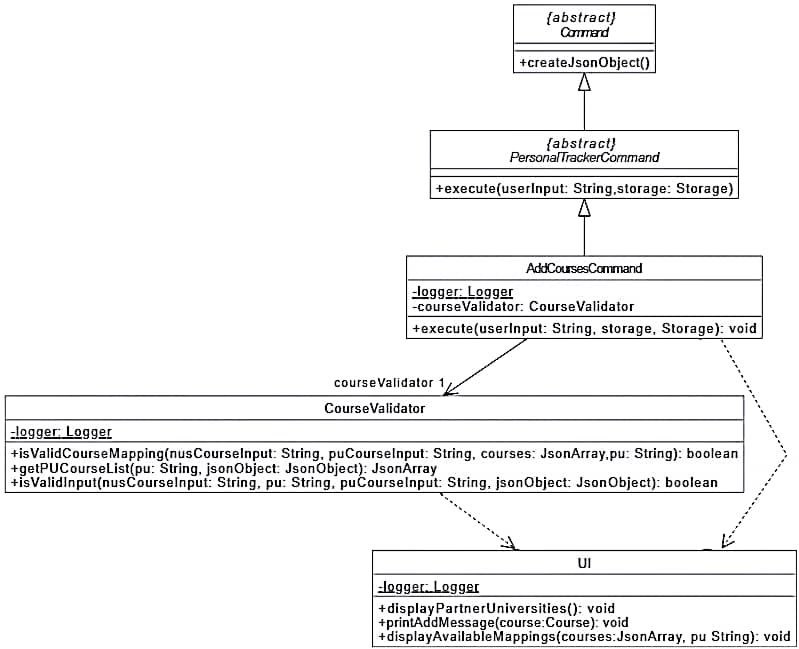
Storage Class Diagram:
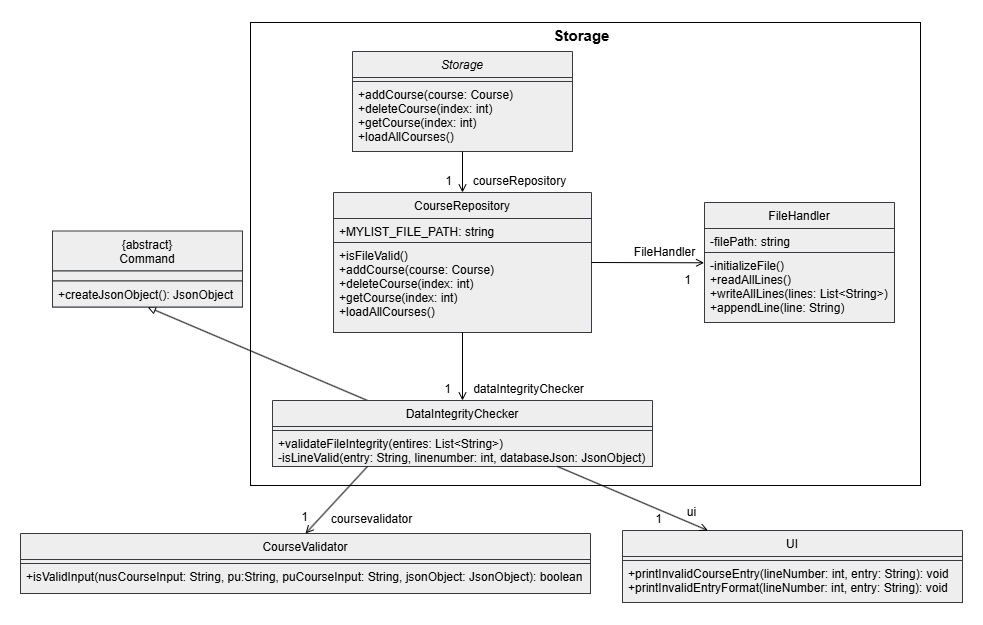
Storage System Overview
The storage system is structured to manage the persistence and integrity of course data for the application. It consists of the following key components:
-
Storage Class: The main interface for adding, deleting, retrieving, and loading courses. It interacts with
CourseRepositoryfor data persistence, ensuring all course-related actions are directed to the appropriate storage location. -
CourseRepository: Acts as an intermediary layer, managing data access and defining the file path (
MYLIST_FILE_PATH) formyList.json. It provides similar methods asStorageto add, delete, and retrieve course data, facilitating structured data storage. -
FileHandler: Responsible for file operations such as initializing, reading, writing, and appending to files. This class abstracts file manipulation, ensuring the storage system can perform reliable file operations without directly managing file-specific details.
-
DataIntegrityChecker: Ensures the integrity of the stored data by validating file structure and content. It provides methods for validating the entire file or individual lines, helping maintain consistent data formatting and correctness.
-
CourseValidator: Validates course inputs to check if they meet predefined criteria before being stored. This ensures that only valid data is added to the repository, reducing the likelihood of errors in the data storage.
-
UI: Responsible for providing feedback to the user regarding any invalid entries or formats, enhancing user experience by notifying them of issues in a clear and informative way.
Each component is designed to separate concerns, with Storage focusing on high-level operations, CourseRepository
on data organization, FileHandler on file I/O, and DataIntegrityChecker on data validation. This modular design
allows for maintainability, testability, and scalability in managing persistent course data.
Implementation
General JSON file reading process

For commands that read through our data source file which contains university data, the process will be done in the
Command class via a createJsonObject() method,
where an IOException message will be displayed if reading fails.
1. List Commands Command
Overview:
The ListCommandsCommand provides users with a comprehensive list of all available commands in the CLI. This is particularly useful for new users or those unfamiliar with specific command formats.
How the feature is implemented:
- The
ListCommandsCommandclass extends theCheckInformationCommandsuperclass and overrides theexecutemethod. - In the
executemethod,printCommandListfrom the UI class is called. - A detailed list of commands with brief descriptions is printed to the CLI , providing users with command syntax and expected usage.
- The command list is formatted for readability with each command on a new line, and
LINE_SEPARATORis used before and after the list to create a visually distinct section in the CLI. - Logging is implemented to track the start and completion of the command, facilitating debugging and traceability.
Why it is implemented that way:
- Ease of Use: Displaying all available commands in one place helps users quickly identify what actions are possible within the application.
- Logging: Logging the start and end of execution helps developers track usage patterns and troubleshoot issues if the command is not functioning as expected.
Alternatives considered:
- Dynamic Command List: Considered dynamically generating the command list from all command classes in the codebase to avoid manually updating this list, but opted for simplicity to prevent added complexity.
- Help Command Integration: Considered integrating
ListCommandsCommandwith theHelpCommandto provide a one-stop command for help-related requests, but separating them ensures clarity and keeps each command focused.
Sequence Diagram:

2. Help Command
Overview
This command provides users with detailed explanations of each feature and the ways to use them. This allows users to navigate this program easily and effectively.
How the feature is implemented:
- The
HelpCommandclass extends theCheckInformationCommandclass where it overrides the execute method for custom behaviour. - First, the user input is passed into the
getCommand()method which extracts and processes the command. It does so by usingswitchstatements to determine if the input matches one of the valid commands. - If it does, it returns the command, if it does not, an
IllegalArgumentExceptionexception will be thrown to handle invalid commands - Then, the
printHelp()method will be called to display the detailed help messages for the specific command. Anotherswitchstatement is used here to map each command to its corresponding help message. - Assertions and logging are implemented for error handling.
Why it is implemented that way:
- Separation of Concerns: Each method has a single responsibility. For example,
getCommand()parses and validates the input to extract a specific command andprintHelp()prints the relevant help message for the parsed command. - Switch Statement: The use of
switchstatement is an efficient way to match valid commands.switchstatements are also clearer and easier to read.
Alternative Implementation considered:
- The use of
if-elsestatement- However, since the condition is a single variable and not complex conditions, it will be cleaner and clearer to use
switchstatements
- However, since the condition is a single variable and not complex conditions, it will be cleaner and clearer to use
Sequence Diagram:
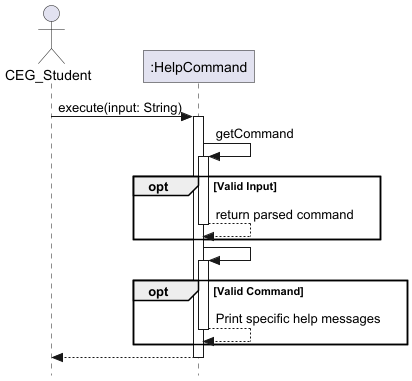
3. List Schools Command
Overview:
This command is responsible for displaying and retrieving the full list of universities from our data source file which contains university data. It helps the users to identify the possible choices in Oceania.
How the feature is implemented:
- The
ListSchoolCommandclass extends theCheckInformationCommandclass where it overrides theexecutemethod for custom behaviour. - The command first reads fetches data from
fetchSchoolData()method from a JSON file to obtain the names viacreateJsonObject()method from the superclass. - The JSON Object retrieved is also validated via the
validateJsonObject()method. - The
displaySchoolList()method will iterate over the keys of the database which contains the University names, upon acquiring the keys, they will be printed over the CLI. - There are also exceptions, assertions and logging in place for error handling.
- Line Separator is used to ensure readability and ease of use for users.
Why it is implemented that way:
- The two methods
displaySchoolList()andexecute()are separated for ease of debugging and code tracing. This is also in line with the idea that each method has a responsibility of its own. - Exception handling for null school name is implemented in case of corruption of the file that contains the school names.
Alternative Implementation considered:
- Considered placing all the class methods inside the
executemethod but kept SLAP in mind to ensure readability. - The abbreviations should have been places in a data folder or another data structure should be utilised rather than an array. But this would raise the complexity of the implementation, hence an array was used to store the abbreviations in the end.
Sequence Diagram:
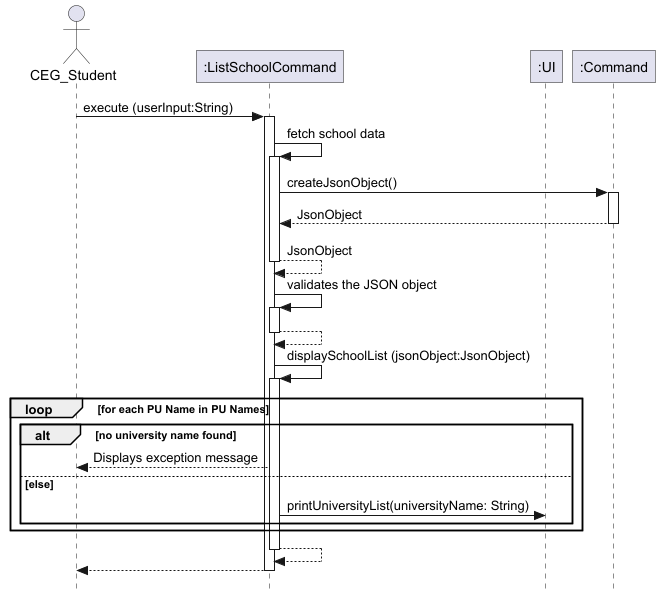
4. List University Courses Command
Overview
This command is responsible for listing out all the mappable partner university’s (PU) courses and NUS courses. This allows users to plan their course mapping as it lists out all the possible courses they can map in a specified partner university.
How the feature is implemented:
- The
ListUniCoursesCommandclass extends theCheckInformationCommandclass where it overrides the execute method for custom behaviour. - The command first reads a JSON file to obtain the JsonObject containing the names of all the partner universities.
- The getPuName method then parses and extracts the PU name from the input (with the format of
list courses [PU_NAME]). - Next, the extracted PU name is passed into the
getUniCourses()method which will search for the specified PU in the JsonObject withfindUniversityName(). - If the university is not found, an exception
UnknownUniversityExceptionwill be thrown. - If the PU is found, the
listCourses()will be called. ThengetUniversityObject()andgetCourseArray()methods will be called to get the JsonObject containing the PU and the JsonArray containing the list of courses it offers. - The two object will be passed into
iterateCourses()method to iterate through the JsonArraycourseArraywhich contains the list of courses. - It then prints out the course details such as PU course code and NUS course code by calling the
printListUniCoursesCommandmethod in the UI class. - Assertions and logging are used for error handling.
Why it is implemented this why:
- Separation of Concerns: Each responsibility is separated into smaller, well-defined methods
For example,
getPuName()focuses on extracting the university name from user input andfindUniversityName()focuses on searching the university in the data set.
Sequence Diagram:

5. Obtain Partner University Email and Contact Number Command
Overview:
The command is responsible to retrieve the email contact and contact number data for a specified partner university. It helps users to reach out to the partner universities for any enquiries about programs or exchange opportunities.
How the feature is implemented:
- The
ObtainContactsCommandclass extends theCheckInformationCommandclass where it overrides theexecute()method for custom behaviour. - The command first reads a JSON file to obtain the names via
createJsonObject()method from the superclass. - The
getSchoolName()andgetContactType()methods are used to parse the user input, extracting the requested university name and contact type (email or phone number). - After parsing, the
findMatchingSchool()method identifies the correct university entry within the JSON data. - During this time, the
isSchoolValid()method inside theSchoolContactValidatorclass is used to check if the school name exists. - If school exists, the
checkValidContact()method checks the validity of the contact type through a handlerisValidContactType()inSchoolContactValidatorclass. - The
contactTypeIdentifier()method then checks retrieves the contact type and displays the contact information via theprintContactInformation()in theUIclass. - There are also exceptions, assertions and logging in place for error handling.
Why it is implemented that way:
- The
executemethod is essential and unique to every command class so inheritance was used. - Validating the contact and school name is crucial and a separate class (
SchoolContactValidator) is used to handle the validity of each input category. This is in line with the separation of concerns where each method has a responsibility. - Every method in the class remains maintainable and has one responsibility this allows easy debugging and refactoring.
- By using inheritance, new command classes can easily extend the functionality of existing ones which reducing redundancy in the code.
- Logging and assertions helps the team of developers to follow through the command execution.
Alternatives considered:
- Split the contacts into 2 different class for obtaining email and number for better separation of concerns
- Reading of the data source file which contains university data was tricky and other libraries were considered.
- Considered placing all the class methods inside the
executemethod but kept SLAP in mind to ensure readability.
Sequence Diagram:
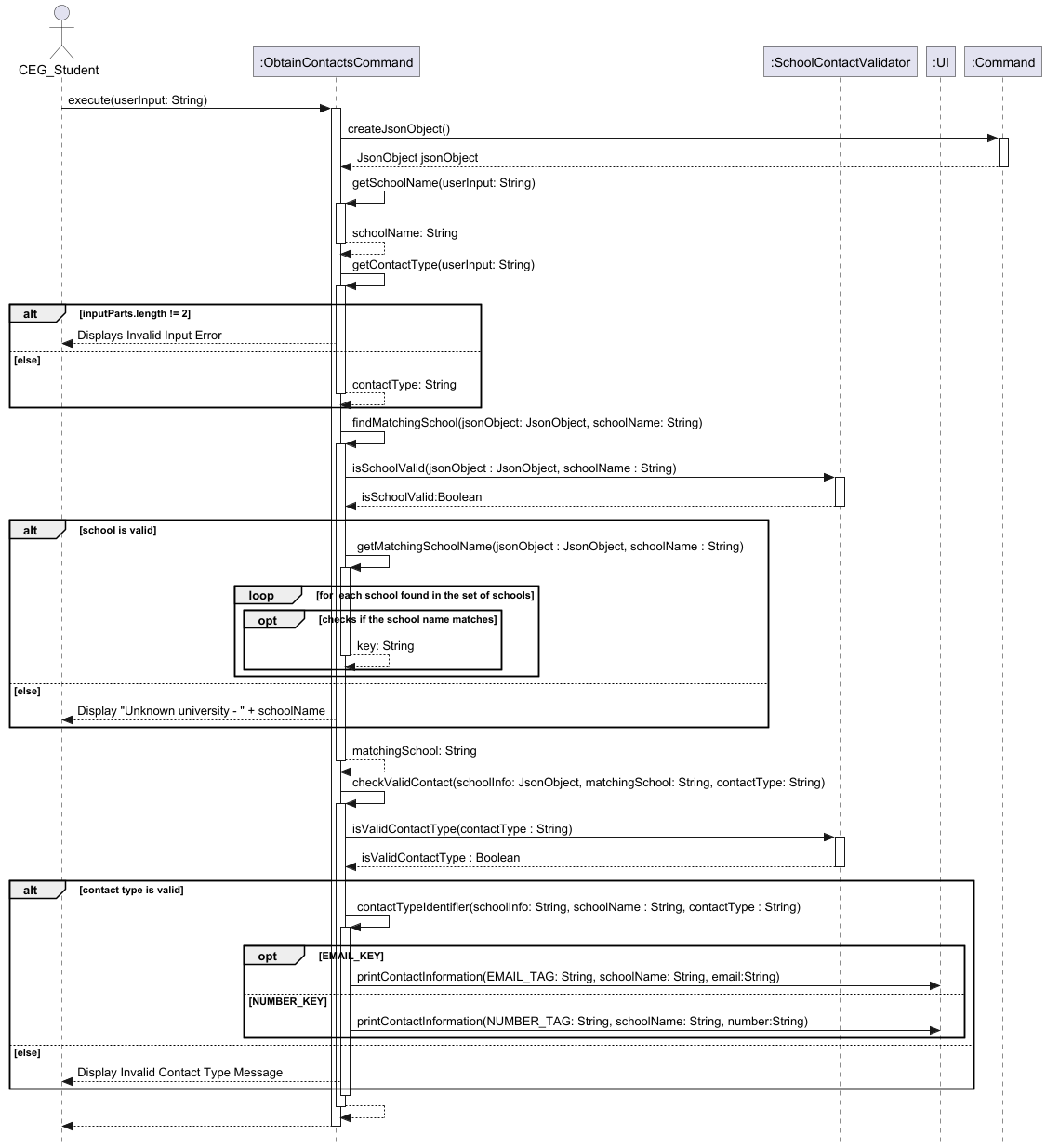
6. Filter Courses Command
Overview:
This command is responsible for displaying and retrieving the full list of mappable courses from the partner universities to a user specified NUS course from our data source file which contains university data. It helps the users to identify whether that NUS course is suitable to be mapped overseas in Oceania.
How the feature is implemented:
- The
FilterCoursesCommandclass extendsCommandclass where it overrides theexecutemethod for custom behaviour. - The command first reads a JSON file to obtain the names via
createJsonObject()method from the superclass. - The
parseFilterCommandmethod then separates input, which parses the user input to extract the details in the input, still ofStringtype. - The
getNusCourseCodemethod then extract out the user specified NUS course code from the parsed input, checking if the course code is a School of Computing course or follows the format of a NUS course code, using the methodsisValidSocCourseCodeandisValidNusCourseCodeFormatmethods in theNusCourseValidatorclass. - The NUS course code is then passed into the
displayMappableCourses()method along with teh Json object. The method will iterate over the keys of the database which contains the University names, then obtain the arraycoursesstored in the “courses” field. Thecoursesarray is then iterated over, for each course, if the value in the “nus_course_code” is equals to the NUS course code passed into the method, the university name and “pu_course_code” value of the course will be printed to the CLI. - There are also assertions and logging in place for error handling.
- Line Separator is used to ensure readability and ease of use for users.
Why it is implemented that way:
- Single Responsibility Principle: The methods to check the user’s input for the NUS course code are extracted
into the
NusCourseCodeValidatorclass, separate from the methods used in theFilterCoursesCommandclass, which are mainly used for the logic behind the filtering of courses.
Sequence Diagram:
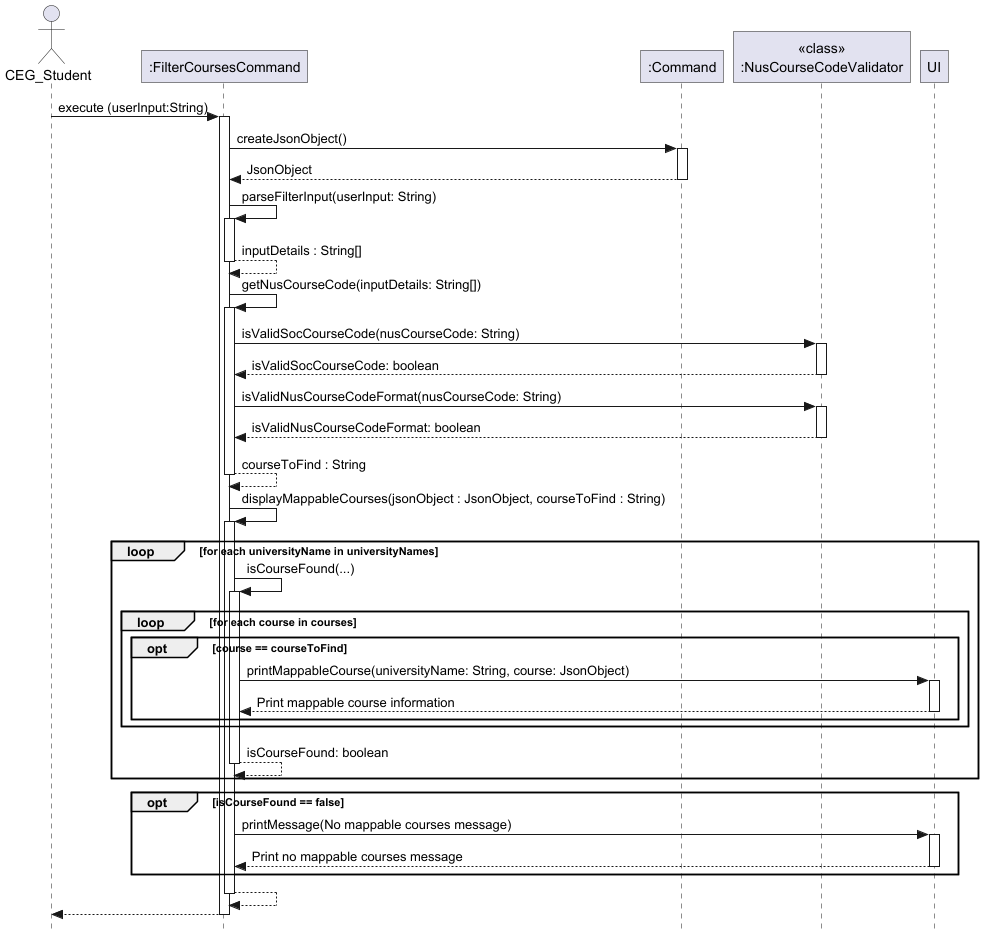
7. Add Courses Command
Overview:
This command is responsible for adding users’ desired course mapping into the myList.json file.
Additionally, each course mapping is checked against the current course mappings found in
our database, to ensure that the course mapping is accurate and is limited
to universities in Oceania. This command hence helps the users to keep track of their course mapping process.
How the feature is implemented:
- The
AddCoursesCommandclass extendsCommandclass where it overrides theexecutemethod for custom behaviour. - The command first reads a JSON file to obtain the course mapping database via the
createJsonObject()method from the superclass. - The
trimStringmethod then removes theaddcommand and checks whether the user gave any input after the command. The method would return the trimmed user’s input without theaddcommand. - This input is then passed into the
parseAddCommand()method to obtain the relevant information: NUS course code, name of partner university and partner university course code. - Specifically, the name of partner university is passed into the
getUniversityAbbreviations()method found in theParserclass to convert any partner university abbreviations to their full form. - Along with the JSON Object created from the
createJSONObject()method, the information extracted from theparseAddCommand()method would be passed to theisValidInput()method to verify the user’s course mapping. - This initiates the course validation process by using the methods found in the
CourseValidatorclass. - Firstly, the
getPUCourseList()method is called to verify if the user’s partner university is included in the database. An exception is thrown if the university is not found in the database. - Afterward, the
isValidCourseMapping()method checks whether the NUS course code and PU course code are compatible for course mapping against the database. - If both checks above are passed, the course mapping would be added to the
myList.jsonfile. - Throughout the code, exceptions, assertions and logging are in place for better error handling.
- Line Separator is used to ensure readability and ease of use for users.
Why is it implemented this way
- The code is separated into distinct methods that addresses a separate concern, achieving Separation of Concerns principle (SoC). This helps to achieve better modularity and readability.
- Each method includes numerous exception handlers to cover as many potential errors and edge cases as possible.
- The methods used in course validation is extracted out and placed in the
CourseValidatorclass to enhance OOP and improve readability.
Alternatives Considered
- Initially, one way to validate a course mapping is by adding all course mappings to a hashmap. This allows indexing to locate the relevant course mapping. However, this approach may lead to unnecessary repetition since each course mapping is already stored in the JSON file.
- Initially, each course mapping is stored as a formatted string. However, this format makes it challenging to verify course mappings and implement methods that need to access course mappings from storage.
Sequence Diagram:
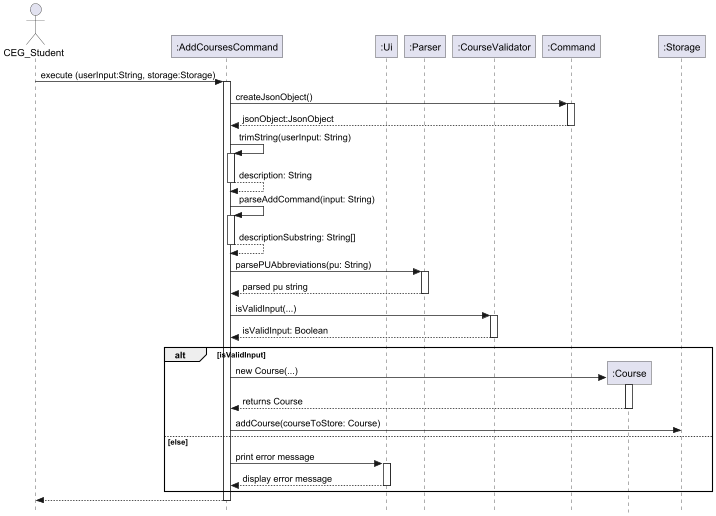
Sequence Diagram of AddCourseCommand
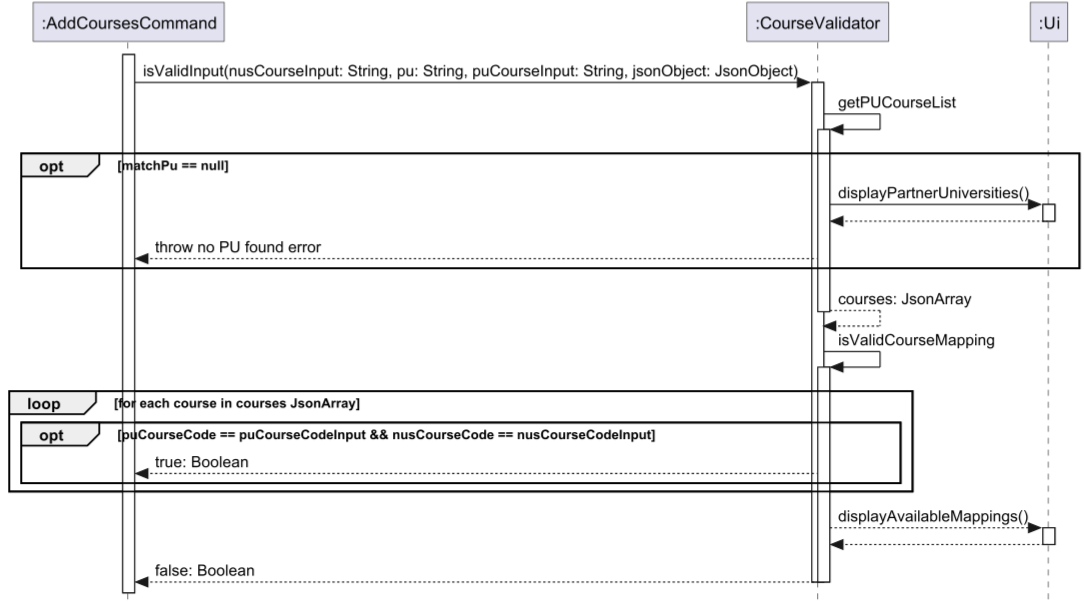
Sequence Diagram of Course Validator (extracted out of AddCourseCommand sequence diagram)
8. Delete Courses Command
Overview:
This command is responsible for deleting users’ existing course mapping plan from the myList.json file.
This helps the users to keep track of their most recent course mapping plans, and to keep the myList.json file organised.
How the feature is implemented:
- The
DeleteCoursesCommandclass extendsCommandclass where it overrides theexecutemethod for custom behaviour. - When
executeis called, the command first passes the user’s input into theparseDeleteCommandmethod, which parses the user input to extract the list index, still ofStringtype, of the course mapping plan they would like to delete. - The parsed input is then passed into the
getListIndexmethod. The list index is then converted to anintusing theIntegerclass. If a valid list index format has been given by the user, the list index is returned. - The list index, along with the Storage object, is passed into the
deleteCoursemethod, which calls thegetCoursemethod from the Storage object, and accesses the line in themyList.jsonfile as specified by the list index to obtain information of the course to delete, then deletes the course using thedeleteCoursemethod from the Storage object. - Lastly, the UI object’s
printDeleteMessageis called to inform the user of the course plan which is deleted. - Throughout the code, exceptions, assertions and logging are in place for better error handling.
- Line Separator is used to ensure readability and ease of use for users.
Why It Is Implemented This Way:
- Ease of deletion: This command ensures that maintaining the Personal Tracker is quick and fast, and is
complemented by the
list mappedcommand, which shows the index of the saved course mapping plans. - User-Friendly Output: The user is notified of the course mapping plan that was deleted, making sure that they have deleted the correct plan.
Sequence Diagram:
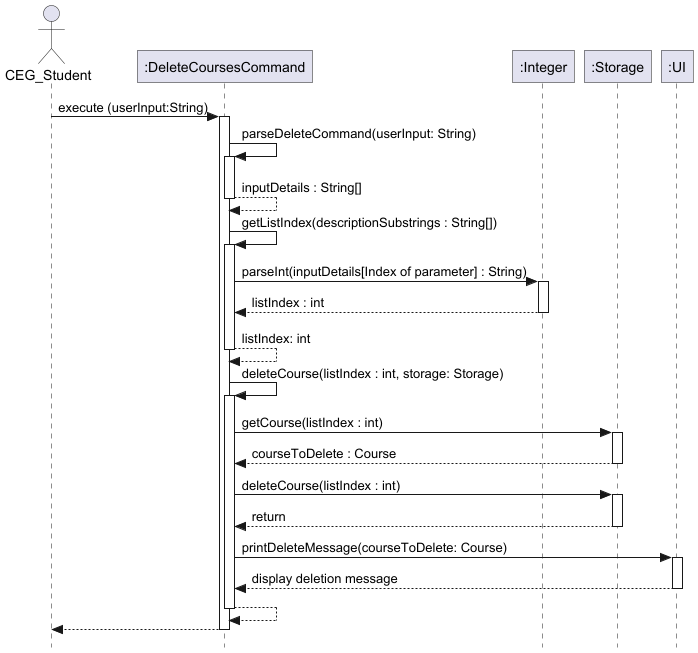
9. ListPersonalTrackerCommand
Overview:
The ListPersonalTrackerCommand is responsible for listing all the mapped modules stored in the user’s personal tracker.
This command retrieves all stored courses from myList.json via the Storage class and displays them in an indexed list format on the CLI.
How the Feature is Implemented:
- The
ListPersonalTrackerCommandclass extendsCheckInformationCommandand overrides theexecutemethod to define custom behavior. - The constructor accepts a
Storageobject to access stored course mappings. - Execution Flow in
executeMethod:- Checks the data integrity of
myList.jsonusingcourseRepository.isFileValidandcourseRepository.hasDuplicateEntries. If the data integrity fails, the command exits without further execution. - Calls
loadAllCoursesfrom the Storage class to retrieve the list of mapped modules. - If the list is empty, a message is displayed to inform the user that no modules have been mapped.
- If there are mapped modules, it logs that modules will be displayed and then:
- Prints a header and a line separator.
- Iterates through
mappedModules, printing each course with an index for readability by callingprintMappedModulesfrom the IU class. - Prints a closing line separator.
- Checks the data integrity of
Why It Is Implemented This Way:
- Single Responsibility: This command is focused on a single responsibility—displaying the list of mapped modules—making it easy to maintain and test.
- User-Friendly Output: By indexing the output and adding line separators, the command ensures a clean and readable output format for users.
Alternative Implementations Considered:
- Direct Output from Storage: An alternative could have been to let the Storage class directly output the list. However, separating the command logic maintains a cleaner architecture and allows more flexibility in how the data is displayed.
- Skipping Indexing: Displaying the list without indexing was considered, but indexing improves readability, especially if the list of modules is long.
Sequence Diagram:
![]()
10. Compare Mapped Command
Overview
The CompareMappedCommand is responsible for comparing course mappings between two specified partner universities.
This command aids users in identifying common course mappings across the selected universities, as well as highlighting
unique course mappings specific to each university.
How the Feature is Implemented
The CompareMappedCommand class extends CheckInformationCommand and overrides the execute method to define its custom behavior.
Below is an outline of the execution flow:
- Checks the data integrity of
myList.jsonusingcourseRepository.isFileValidandcourseRepository.hasDuplicateEntries. If the data integrity fails, the command exits without further execution. - The command splits the user input based on the delimiter
pu/to retrieve the names of the two universities specified by the user.- If fewer than two universities are specified, the
printInvalidInputFormatmethod in theUIclass is called to inform the user of incorrect input format.
- If fewer than two universities are specified, the
- The command calls
isValidUniversityto check if the input is a valid university. Otherwise, it will print an error message with the wrong university name and a suggestion. - The command loads all course mappings from the
myList.jsonfile through theStorageclass. - It verifies that the loaded list is not
nullthrough assertions. - The
filterModulesByUniversitymethod takes the list of all modules and filters out only those associated with the specified university. - Logging is used to track this filtering process.
- The
extractCourseCodesmethod extracts the unique course codes for each university, enabling the subsequent comparison. - The
getCommonCourseCodesmethod calculates the intersection of course codes between the two universities, identifying courses available in both. - The
getUniqueCourseCodesmethod identifies unique courses by excluding the common course codes for each university. - The
displayComparisonResultsmethod provides output for the comparison:- Common mappings are displayed first, showing courses available in both universities.
- Unique mappings are shown next, detailing courses specific to each university.
- The output format is controlled through methods in the
UIclass for better readability and user experience.
Why it is Implemented this Way
- Separation of Concerns: Methods are organized by function, with each handling a specific part of the comparison logic. This promotes code readability and maintainability.
Alternatives Considered
- Combined Filtering and Extraction: Initially, filtering and course code extraction were considered for a single method, but separating them simplified the debugging process and enhanced the code structure.
- Display Inline in
execute: Displaying results directly in theexecutemethod was an option. However, using dedicated methods (e.g.,displayComparisonResults) improved readability and made testing individual components easier.
Sequence Diagram:
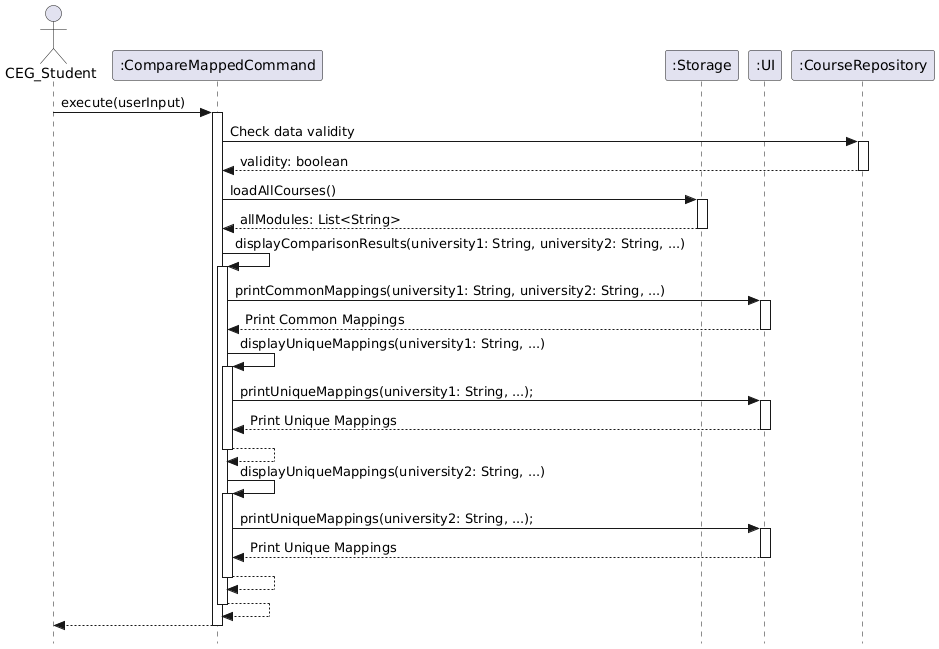
11. Find course mapping command
Overview
This command is responsible for the searching of a particular NUS course in the personalised tracker. This allows users to check and plan course mappings for that specified course.
How the feature is implemented:
- The
FindCoursesCommandclass extends theCheckInformationCommandclass where it overrides the execute method for custom behaviour specific to this class. - The input from the user is first parsed through the
getKeyword()method to extract out the keyword(NUS course code) to search within the personalised tracker. If there is no keyword, anIllegalArgumentExceptionwill be thrown. - Then the keyword will be passed to the
findCommand()method. - In the
findCommandmethod, the mappings in the tracker are retrieved throughList<Course> mappedCourses = storage.loadAllCourses(). If the tracker is empty, a message indicating empty tracker will be printed. - Next,
matchKeyword()will be called, and it iterates the mappedCourses in the tracker to search for mappings that match the keyword and adds them into aList<Course> foundCourses. - Lastly,
printFindCommandwill iterate and print the course mappings inside mappedCourses throughprintFoundCourses()inUIclass. If mappedCourses is empty, an IllegalArgumentException is thrown.
Why it is implemented this way:
- Separation of concerns: Helper methods were used to isolate specific tasks within the command, making each
method focused and easier to manage. The
UIclass handles displaying messages to the user, which keepsFindCoursesCommandfocused solely on search logic, without managing user interactions directly.

Product scope
Target user profile
- CEG students keen to go for SEP and need a clear and organised UI to see course mappings
- CEG students who want to plan their schools and courses to take
- Can type fast
- Prefers typing to mouse interactions
- Is reasonably comfortable using CLI apps
Value proposition
- CEG students can manage SEP planning faster than a typical mouse/GUI driven app (EduRec)
- CEG students can use ExchangeCourseMapper to expedite their for course mapping process by listing universities and specific courses with their subject codes
- CEG students can easily filter by either NUS-coded modules or partner universities (PU) to quickly identify relevant course options.
- CEG students can easily load and save the saved courses in a data file for safekeeping
- The CLI interface provides an efficient experience for users focused on planning their SEP with precision.
User Stories
| Version | As a … | I want to … | So that I can … |
|---|---|---|---|
| v1.0 | CEG student | see the possible Oceania Universities for CEG students | see all my possible choices in that region |
| v1.0 | CEG student | search for NUS courses to map | search for related courses in PUs |
| v1.0 | CEG student | key in the school I want to go for exchange | view the available course offered by the school |
| v1.0 | CEG student | want to see a list of commands | know what to do to go to access the features |
| v2.0 | CEG student | obtain the email address of the partner universities | send an email should I have any non-urgent queries |
| v2.0 | CEG student | obtain the contact number of the partner universities | call the number should I have any urgent queries |
| v2.0 | CEG student | add a course mapping plan for a PU | keep track of my courses for a specific PU |
| v2.0 | CEG student | list out the mapped courses by calling the list command | I can track all the courses I have mapped to the different PUs |
| v2.0 | CEG student | delete a course mapping plan for a PU | keep my list of saved plans organised |
| v2.0 | CEG student | ask for help when I am in doubt | know what are the possible actions |
| v2.0 | CEG student | compare different mapping plans for each PU | find the university best fit for my academic schedule |
| v2.0 | CEG student | search for course mappings in my personalised tracker | check if I have mappings for that course |
Non-Functional Requirements
- Access to a computer with Java 17 installed and an IDE that supports Java programming.
- A CEG student with above average typing speed for regular English text (i.e. not code, not system admin commands) should be able to accomplish most of the tasks faster using commands than using the mouse.
- A CEG student should be able to maintain long term usage without a noticeable sluggishness in performance for typical usage.
- CEG student who is interested in planning SEP course mapping to universities in Oceania.
Glossary
- Mainstream OS: Windows, Linux, Unix, macOS
- CEG: Computer Engineering
- PU: Partner University
- CLI: Command Line Interface
- SEP: Student Exchange Programme
Instructions for manual testing
[NOTE!] These instructions only provide a starting point for testers to work on; testers are expected to do more exploratory testing.
[NOTE!] SCHOOL_NAME inputs for the commands:
list courses,obtain,add,compareare not case-sensitive, and you can either input the University’s full name, or its abbreviation.
1. Start ExchangeCourseMapper
- Follow the instructions in our User Guide Quick Start
- Expected: Welcome message on the terminal, prompting for the user’s input
2. Test Cases
2.1 Start State
- 2.1.1. Introduction to ExchangeCourseMapper
- Test Case:
commands - Expected: Prints out the summarised list of possible commands in ExchangeCourseMapper.
- Test Case:
- 2.1.2. More details for each command listed by the
commandscommand- Test Case:
help add - Expected: Prints out the function of the add function and the valid command format.
- Test Case:
2.2 Obtain names of Partner Universities in Oceania
- 2.2.1 List all Partner Universities (PUs) in Oceania
- Prerequisites: None
- Test Case:
list schools - Expected: List of names and abbreviations of PUs in Oceania.
2.3 Find mappable courses in a specific PU in Oceania
- 2.3.1 See all mappable courses from a valid PU (Using full university name)
- Prerequisites: None
- Test Case:
list courses The University of Western Australia - Expected: List of mappable courses, with information of the PU course code and name to the matching NUS course code and name.
- 2.3.1 See all mappable courses from a valid PU (Using university abbreviation)
- Prerequisites: None
- Test Case:
list courses uwa - Expected: List of mappable courses, with information of the PU course code and name to the matching NUS course code and name.
- 2.3.2 See all mappable courses from an invalid PU
- Prerequisites: None
- Test Case:
list courses tokyo university - Expected: Error message stating that input is an unknown university to ExchangeCourseMapper.
2.4 Obtain admin information of PUs in Oceania
- 2.4.1 Obtain valid PU’s email
- Prerequisites: None
- Test Case:
obtain The University of Melbourne /email - Expected: Prints out email of The University of Melbourne.
- 2.4.3 Obtain valid PU’s email
- Prerequisites: None
- Test Case:
obtain The University of Melbourne /number - Expected: Prints out email The University of Melbourne.
- 2.4.2 Obtain invalid PU’s email or number
- Prerequisites: None
- Test Case:
obtain tokyo university /emailorobtain tokyo university /number - Expected: Error message stating that input is an unknown university in the program.
2.5 Filter and obtain mappable courses for a specific NUS SoC course code
- 2.5.1 Filter using a valid SoC course code with possible mappings
- Prerequisites: None
- Test Case:
filter cs3241 - Expected: Prints out all the courses offered by the PUs that can be mapped to cs3241.
- 2.5.3 Filter using a non-SoC course code
- Prerequisites: None
- Test Case:
filter gess1010 - Expected: Prints out error message stating that filter only works for CS/CG/BT/IS/EE courses.
- 2.5.3 Filter using a wrongly formatted NUS course code
- Prerequisites: None
- Test Case:
filter eeeeeeeeeee - Expected: Prints out error message to guide users on the format of the NUS course code to input with the command.
2.6 Add course mapping plans into Personal Tracker
- 2.6.1 Add course mappings with the correct format and valid mapping (Using full university name)
- Prerequisites: None
- Test case:
add CS2040 /pu The university of western australia /coursepu CITS2200 - Expected: Prints out a confirmation message indicating success.
- 2.6.2 Add course mappings with the correct format and valid mapping (Using University abbreviation)
- Prerequisites: None
- Test case:
add cs3241 /pu unimelb /coursepu comp30019 - Expected: Prints out a confirmation message indicating success.
- 2.6.3 Add course mapping with incorrect format
- Prerequisites: None
- Test case 1:
add invalid format - Test case 2:
add cs2040 /pu invalid uni - Test case 3:
add cs2040 /pu the university of western australia - Expected: Prints out error message indicating to provide all valid parts.
- 2.6.4 Add course mappings with invalid NUS course code/ PU course code
- Prerequisites: None
- Test case 1:
add CS1231 /pu the university of western australia /coursepu CITS2200 - Test case 2:
add CS2040 /pu the university of western australia /coursepu CITS1111 - Expected: Prints out error message and a list of mappable courses offered by the PU in the format of
NUS COURSE | PU COURSE.
- 2.6.5 Add course mappings with invalid partner university (PU) name
- Prerequisites: None
- Test case:
add CS2040 /pu the university of australia /coursepu CITS2200 - Expected: Prints out error message and a list of partner universities with name and abbreviations.
2.7 Delete course mapping plans into Personal Tracker
- 2.7.1 Delete course mapping plan with valid task number
- Prerequisites: at least one course mapping plan in tracker
- Test case:
delete 1 - Expected: Prints a confirmation message indicating a success in deletion of the course mapping.
- 2.7.2 Delete course mapping plan with invalid task number
- Prerequisites: less than 100 course mapping plans in tracker
- Test case:
delete 100 - Expected: Prints out error message indicating to provide valid index and a prompt to list out the available mappings in personal tracker.
[NOTE!] The tests below would require the tester to corrupt the
myList.jsonfile stored in the data folder (found in the directory where the tester’s terminal is running from).To corrupt data: At least one saved course mapping plan saved in myList.json, then remove any of the information (NUS course code, Partner University’s name or the course that it offers which is mappable to the NUS course code).
To fix the file: Revert all changes, and make sure that there is no new line after the last course mapping plan.
2.8 Listing out all saved course mapping plans in Personal Tracker
Non-corrupted data file
- 2.8.1 Listing an empty data file
- Prerequisites: None
- Test Case:
list mapped - Expected: Prints out message that the user has not saved any course mapping plans yet.
- 2.8.2 Listing a non-empty data file
- Prerequisites: At least one saved course mapping plan saved in myList.json
- Test Case:
list mapped - Expected: Prints out list of saved course mapping plans, each containing information on: NUS course code, Partner University’s name and the course that it offers which is mappable to the NUS course code.
Corrupted data file
- 2.8.3 Listing a non-empty data file
- Prerequisites: Corrupted data file (follow note above Section 2.8)
- Test Case:
list mapped - Expected: Prints out an error message notifying user which line in myList.json is corrupted.
- Please revert back to the file original stage (prior to corruption) before continuing on with the manual testing. (follow note above Section 2.8)
2.9 Compare saved course mapping plans between universities
Non-corrupted data file
- 2.9.1 Comparing with an empty data file
- Prerequisites: None
- Test Case:
compare pu/the university of melbourne pu/the university of western australia - Expected: Prints out message that there are no unique mappings currently saved for each given PU.
- 2.9.2 Comparing with a non-empty data file
- Prerequisites: At least one saved course mapping plan saved in myList.json, for either The University of Melbourne or The University of Western Australia.
- Test Case:
compare pu/the university of melbourne pu/the university of western australia - Expected: Prints out message with the unique mappings currently saved for each given PU.
Corrupted data file
- 2.9.3 Listing a non-empty data file
- Prerequisites: Corrupted data file (follow note above Section 2.8)
- Test Case:
compare pu/the university of melbourne pu/the university of western australia - Expected: Prints out an error message notifying user which line in myList.json is corrupted.
- Please revert back to the file original stage (prior to corruption) before continuing on with the manual testing. (follow note above Section 2.8)
2.10 Find course mappings in Personal Tracker
- 2.10.1 Find course mapping plan with NUS course that is in the personal tracker
- Prerequisites: This course mapping saved
CS2040 | The university of western australia | CITS2200 - Test case:
find cs2040 - Expected: Prints out the course mappings in the format of *
- Prerequisites: This course mapping saved
- 2.10.2 Find course mapping plan when the personal tracker is empty
- Prerequisites: No course mapping plan in the tracker
- Test case:
find cs2040 - Expected: Prints out error message indicating the list is empty and to ensure there are course mappings in the list.
- 2.10.3 Find course mapping with invalid keywords
- Prerequisites: At least one course mapping plan in the tracker
- Test case:
find cs - Expected: Prints out an error message indicating no match found.
- Note that invalid keywords can mean a NUS course not in the tracker too.
- 2.10.4 Find course with no keyword
- Prerequisites: None
- Test case:
find - Expected: Prints out an error message indicating keyword is empty.